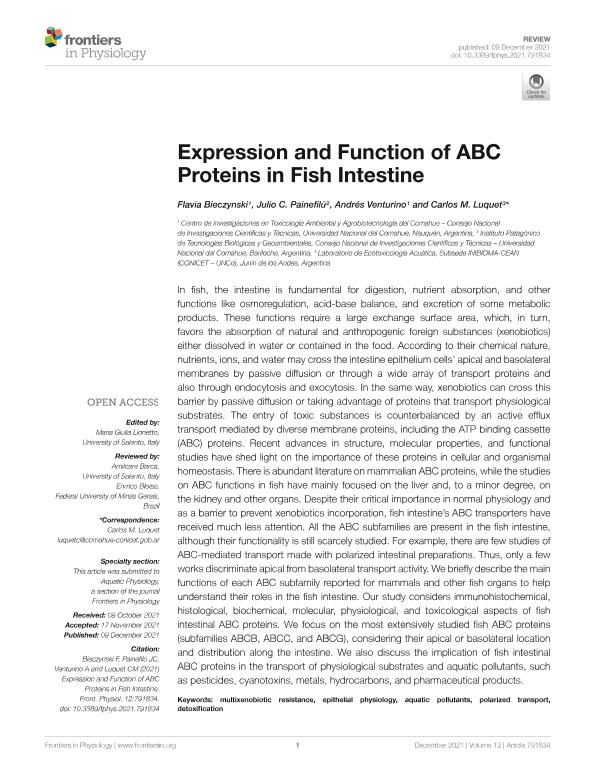Mostrar el registro sencillo del ítem
dc.contributor.author
Bieczynski, Flavia

dc.contributor.author
Painefilú, Julio César

dc.contributor.author
Venturino, Andres

dc.contributor.author
Luquet, Carlos Marcelo

dc.date.available
2023-09-22T14:45:44Z
dc.date.issued
2021-12
dc.identifier.citation
Bieczynski, Flavia; Painefilú, Julio César; Venturino, Andres; Luquet, Carlos Marcelo; Expression and Function of ABC Proteins in Fish Intestine; Frontiers Media; Frontiers in Physiology; 12; 12-2021; 1-21
dc.identifier.issn
1664-042X
dc.identifier.uri
http://hdl.handle.net/11336/212696
dc.description.abstract
In fish, the intestine is fundamental for digestion, nutrient absorption, and other functions like osmoregulation, acid-base balance, and excretion of some metabolic products. These functions require a large exchange surface area, which, in turn, favors the absorption of natural and anthropogenic foreign substances (xenobiotics) either dissolved in water or contained in the food. According to their chemical nature, nutrients, ions, and water may cross the intestine epithelium cells’ apical and basolateral membranes by passive diffusion or through a wide array of transport proteins and also through endocytosis and exocytosis. In the same way, xenobiotics can cross this barrier by passive diffusion or taking advantage of proteins that transport physiological substrates. The entry of toxic substances is counterbalanced by an active efflux transport mediated by diverse membrane proteins, including the ATP binding cassette (ABC) proteins. Recent advances in structure, molecular properties, and functional studies have shed light on the importance of these proteins in cellular and organismal homeostasis. There is abundant literature on mammalian ABC proteins, while the studies on ABC functions in fish have mainly focused on the liver and, to a minor degree, on the kidney and other organs. Despite their critical importance in normal physiology and as a barrier to prevent xenobiotics incorporation, fish intestine’s ABC transporters have received much less attention. All the ABC subfamilies are present in the fish intestine, although their functionality is still scarcely studied. For example, there are few studies of ABC-mediated transport made with polarized intestinal preparations. Thus, only a few works discriminate apical from basolateral transport activity. We briefly describe the main functions of each ABC subfamily reported for mammals and other fish organs to help understand their roles in the fish intestine. Our study considers immunohistochemical, histological, biochemical, molecular, physiological, and toxicological aspects of fish intestinal ABC proteins. We focus on the most extensively studied fish ABC proteins (subfamilies ABCB, ABCC, and ABCG), considering their apical or basolateral location and distribution along the intestine. We also discuss the implication of fish intestinal ABC proteins in the transport of physiological substrates and aquatic pollutants, such as pesticides, cyanotoxins, metals, hydrocarbons, and pharmaceutical products.
dc.format
application/pdf
dc.language.iso
eng
dc.publisher
Frontiers Media

dc.rights
info:eu-repo/semantics/openAccess
dc.rights.uri
https://creativecommons.org/licenses/by-nc-sa/2.5/ar/
dc.subject
AQUATIC POLLUTANTS
dc.subject
DETOXIFICATION
dc.subject
EPITHELIAL PHYSIOLOGY
dc.subject
MULTIXENOBIOTIC RESISTANCE
dc.subject
POLARIZED TRANSPORT
dc.subject.classification
Bioquímica y Biología Molecular

dc.subject.classification
Ciencias Biológicas

dc.subject.classification
CIENCIAS NATURALES Y EXACTAS

dc.title
Expression and Function of ABC Proteins in Fish Intestine
dc.type
info:eu-repo/semantics/article
dc.type
info:ar-repo/semantics/artículo
dc.type
info:eu-repo/semantics/publishedVersion
dc.date.updated
2023-09-19T13:11:54Z
dc.journal.volume
12
dc.journal.pagination
1-21
dc.journal.pais
Suiza

dc.description.fil
Fil: Bieczynski, Flavia. Consejo Nacional de Investigaciones Científicas y Técnicas. Centro Científico Tecnológico Conicet - Patagonia Norte. Centro de Investigaciones en Toxicología Ambiental y Agrobiotecnología del Comahue. Universidad Nacional del Comahue. Facultad de Ciencias Agrarias. Centro de Investigaciones en Toxicología Ambiental y Agrobiotecnología del Comahue; Argentina
dc.description.fil
Fil: Painefilú, Julio César. Consejo Nacional de Investigaciones Científicas y Técnicas. Centro Científico Tecnológico Conicet - Patagonia Norte. Instituto de Investigaciones en Biodiversidad y Medioambiente. Universidad Nacional del Comahue. Centro Regional Universidad Bariloche. Instituto de Investigaciones en Biodiversidad y Medioambiente; Argentina
dc.description.fil
Fil: Venturino, Andres. Consejo Nacional de Investigaciones Científicas y Técnicas. Centro Científico Tecnológico Conicet - Patagonia Norte. Centro de Investigaciones en Toxicología Ambiental y Agrobiotecnología del Comahue. Universidad Nacional del Comahue. Facultad de Ciencias Agrarias. Centro de Investigaciones en Toxicología Ambiental y Agrobiotecnología del Comahue; Argentina
dc.description.fil
Fil: Luquet, Carlos Marcelo. Consejo Nacional de Investigaciones Científicas y Técnicas. Centro Científico Tecnológico Conicet - Patagonia Norte. Instituto de Investigaciones en Biodiversidad y Medioambiente. Universidad Nacional del Comahue. Centro Regional Universidad Bariloche. Instituto de Investigaciones en Biodiversidad y Medioambiente; Argentina
dc.journal.title
Frontiers in Physiology
dc.relation.alternativeid
info:eu-repo/semantics/altIdentifier/url/https://www.frontiersin.org/articles/10.3389/fphys.2021.791834/full
dc.relation.alternativeid
info:eu-repo/semantics/altIdentifier/doi/http://dx.doi.org/10.3389/fphys.2021.791834
Archivos asociados
